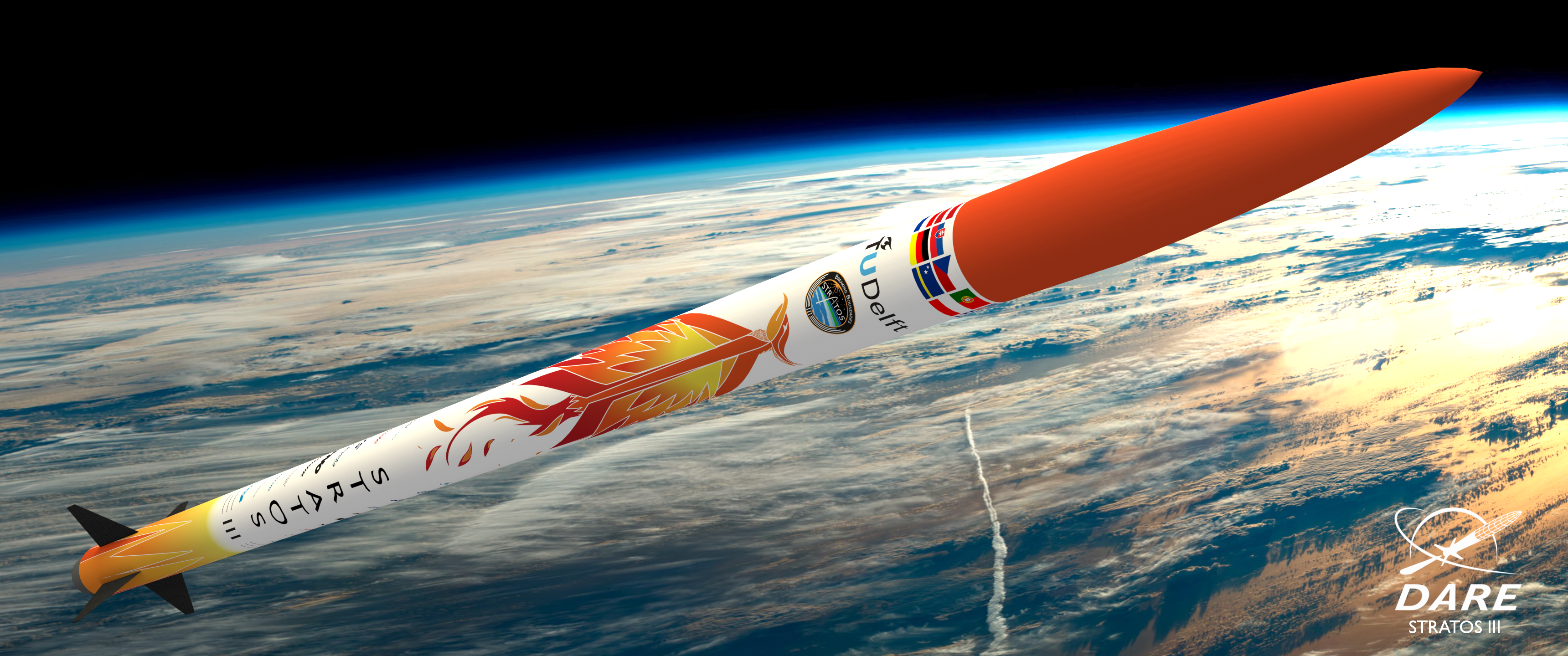
Our biggest yet.
On the fortunately warm summer day of Wednesday the 24th of May at 16:00, Project Stratos unveiled their new design for DARE’s next successor to their previous record-breaking rocket, StratosII+. To start off the event, the after-movie of the StratosII+ launch campaign depicted the pure excitement and childlike curiosity in the members who gave blood, sweat and tears to make common dreams become a realisation before their eyes. The video follows for those who have not yet seen DARE’s biggest achievement, thus far.
So where to from here following the record-breaking StratosII+? Of course, being enthusiast rocket engineers, there is one thing we like to do more than anything else and that is to simulate results before launching our metaphorical ‘basket of eggs’ into space. So as to not ruin any surprises other than what was presented during the unveiling, we can only guarantee without a doubt, something which has been known since the conclusion of StratosII+:
“… the next one is going to be even more exciting than this.”
-Stefan Powell, DARE Alumni Member
As explored by Felix Lindemann, Project Manager of Stratos III, during the opening of his presentation: “what is possible” for a student team? Can they “launch a satellite”? Or perhaps even “go to the moon”? This is, of course, a step further from where we are today, but there exists no problem in dreaming big and whatever the case may be in the years to come, we know with certainty what we will be seeing this year.
Stratos III’s mission is simple, “to improve the current European student altitude record for rocketry” which is currently set by HyEnD, a German student team, at 32.3 km. Although this is not where the sole motives of DARE reside. It is far more complicated in terms of the actual influence that DARE has on its members and those who may someday find themselves interested in joining. This is summarised better by none other than Felix during his unveiling of the Stratos III design.
“We want to inspire young engineers and we want to teach them.”
-Felix Lindemann, Team Manager of Stratos III
Now onto the technical details which were presented by Stijn Koehler, Chief Engineer of Stratos III. Perhaps the most important component in defining a rocket, the engine, for which Stratos III will be using the newly designed DHX-400 Nimbus engine which has the following specifications:
- Fuel: Sorbital, Parafine & Aluminium
- Oxidiser: Nitrous Oxide
- Engine Length: 1.7 m
- Nominal Thrust: 15 kN
- Burn time: 28 s
An enormous amount of time went into designing the engine with consideration of manufacturing techniques at the forefront of the field such as is shown by the implementation of a 3D-printed titanium nozzle and a carbon fibre composite combustion chamber. This, in turn, reduced the weight for the same – if not improved structural resilience when compared to Stratos II+. For comparative purposes, Stratos II+’s oxidiser tank was designed with a 112 L capacity with a weight of 36 kg while Stratos III will be sporting a tank at the same weight but with more than twice the capacity! The value in question is 262 L. The testing of the engine can be seen in the “Stratos III Design Presentation” at the end of the post. For the exact moment of testing, click on the following link (31m 9s). Other features of note for Stratos III are as follow:
- Total Weight: 329.4 kg
- Empty Weight: 104 kg
- Rocket Length: 8 m
- Other: Live streaming capabilities
Now for those of you wondering: ‘How high will Stratos III go?’ Well, unfortunately, we can’t give you an exact number because there is uncertainty associated with the results of our simulations dictated by the unforgiving field of rocketry. This, of course, applies to even the professionals in the field as seen by SpaceX, when their Falcon 9 failed to land on the 15th of June, 2016. This is only to say that there are sometimes unforeseen events in rocketry, which explain the tremendous amount of safety procedures we follow, each and every single launch day. Nonetheless, Stijn attempts to answer the question in order to satisfy your curiosity:
“It should be possible to atleast go to around 80 km, that is where most of the cases go and if we’re really luck we can go to 100 km but also if we’re really unlucky, we can only go to about 25 km.”
-Stijn Koehler, Chief Engineer of Stratos III
‘Cases’ in this context refer to the simulations carried out based on the design parameters of the rocket. To conclude, I will leave you with the full Stratos III Design Presentation. So what are your thoughts? Do you feel DARE will be breaking the European altitude record of 32.3 km? Or perhaps you have some questions that can be better clarified in the comments, feel free to post. Furthermore, we wish the best of luck to the Stratos III team in the coming months!


3 Responses
Hi guys,
Great presentation, best of luck! She’s going to look great, looking forward seeing her fly 🙂
Best regards from Copenhagen,
Jop Nijenhuis
Hey Jop!
Thank you so much :). We also cannot wait to see her break boundaries!
Good luck there in Copenhagen!
Hello, Everyone!
This is awesome, I have been following the project for about two years, I am very enthusiastic about it.
I wish to be one of the team members. That is why, even my graduation project was a rocket design because of my passion about rockets.
I was so much exciting during watching the live podcast of the previous launch.
I wish for you the best and great success.
With respect,
Islam Mansour
Comments are closed.